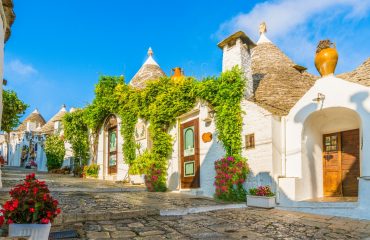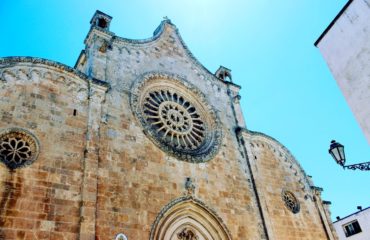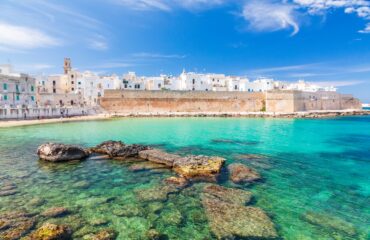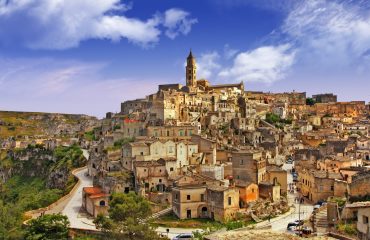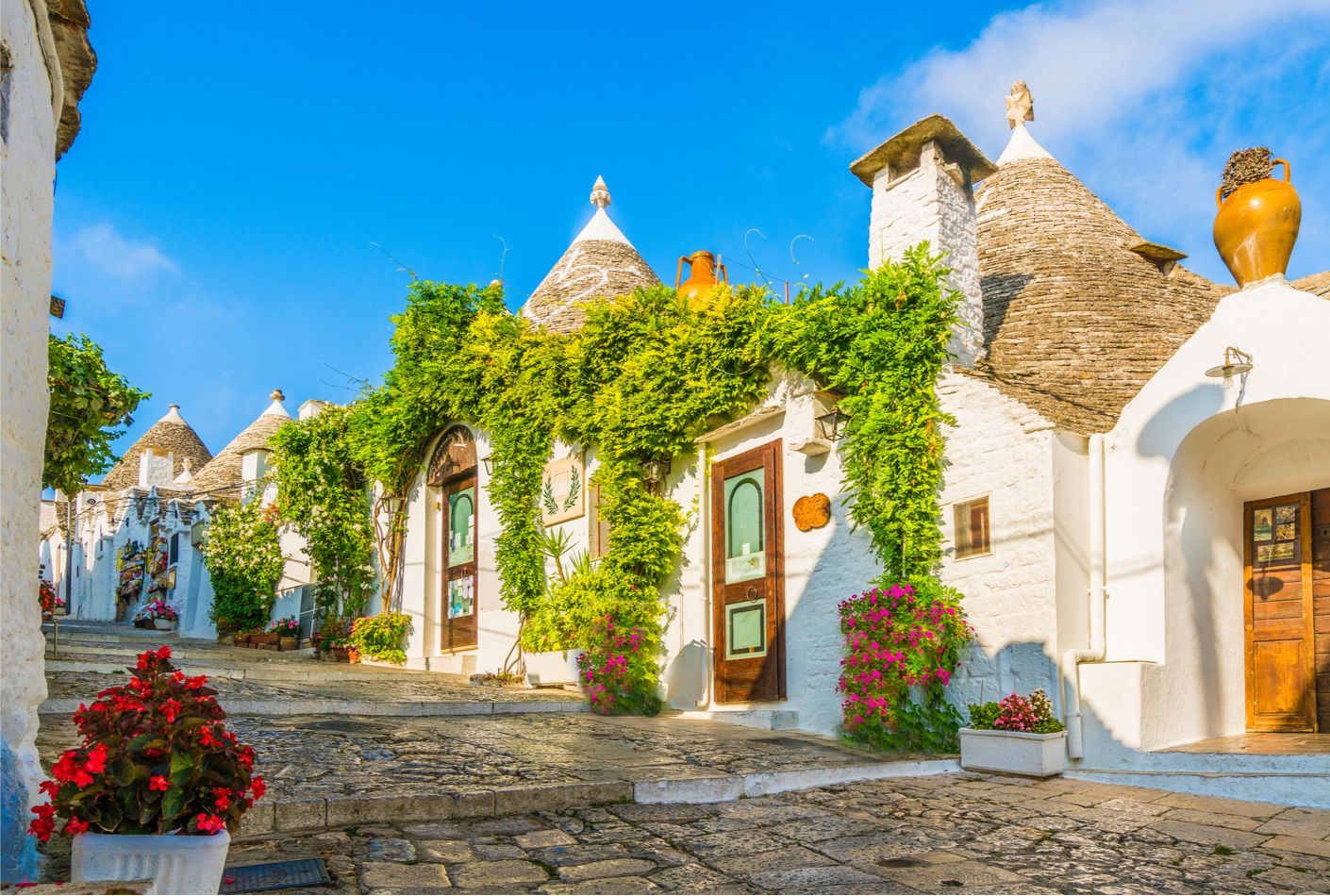
HIT THE HEEL
Puglia
Starting from €16.000 (for two guests)
- Pick up precious cooking tips and unlock the secrets of Apulian cuisine in a hands-on cooking class led by a local gourmand
- Discover how a 15th century tax fraud eventually led to the creation of a UNESCO World Heritage Site as you admire Alberobello’s iconic trulli
- Enjoy a tour of Matera’s fascinating Sassi and imagine how life might have been for cave dwellers 7,000 years ago
-
Duration9 days / 8 nights
-
Category
-
Day 1
Arrive in Lecce
Upon arrival at the airport, meet your private driver and reach your hotel in Lecce where you will be staying for 3 nights.
Following check in, which will take place after 2:00 or 3:00 PM, spend the rest of the day at leisure.
-
Day 2
Full day tour of Otranto & Lecce
Welcome to the heel of Italy. You are bound to fall in love with Apulia’s southern beauties on this private guided tour of Otranto and Lecce.
Meet your guide and driver outside your accommodation in Lecce and begin your day with a 35-minute ride to Otranto. This coastal town’s fortunes and tragedies are inextricably linked to the sea. Otranto thrived under Roman rule becoming one of the south’s most important trading ports, as well as a departure point for military expeditions to the east. However, Otranto’s position also made it vulnerable to attack, as you can see from the following painful chapter in the history of the city. In July 1480 a Turkish fleet of around 150 ships carrying 18,000 soldiers landed here and laid siege to the town. After two weeks of heroic resistance the local population was forced to surrender following the assaults of commander Gedik Ahmed Pasha and his troops who stormed the castle, murdered all males over the age of 15 and sold the women and children as slaves. Eight hundred survivors barricaded themselves inside the cathedral but were soon captured, forced to renounce their faith and either convert to Islam or die. They all refused…
The earthly remains of the Blessed Martyrs of Otranto now rest in the Romanesque Cathedral of Santa Maria Annunziata, the town’s most famous attraction. Step inside to admire the impressive 12th century floor mosaic, a true masterpiece of craftsmanship representing the tree of life. Your guide will accompany you on a walk through the streets of this picturesque town and make sure you take note of its highlights: the imposing 16th century castle, the Byzantine Church of St. Peter, the lively sea-front promenade, the gorgeous white sandy beaches.
After some free time for lunch, it’s time to explore the charming streets and squares of the so-called Firenze del Sud – meaning “Florence of the South”. This nickname did not appear by chance, but Lecce is a true work of art in its very own right. Splendid architecture, fine wine, top-class olive oil, a vibrant contemporary arts and crafts scene… the city is a just as much of a treasure as its Tuscan counterpart.
Lecce’s roots stretch way back in time, to the Romans and beyond, though it wasn’t until rather later that the city blossomed into the extraordinary triumph we can admire today. After centuries of invasions, sieges, raids and neglect, the defeat of the Ottoman Empire at the Battle of Lepanto in 1571 marked the beginning of a period of peace and prosperity which triggered Apulia’s cultural and artistic revival. Over the course of one hundred years Lecce altered radically, changing from a garrison into a dazzling Baroque gem. The construction of defensive watchtowers and fortified strongholds gave way to the building of magnificent churches and elaborately decorated palazzi.
The local honey-hued limestone is largely responsible for Lecce’s unique appearance and architectural style. Soft, malleable and ideally suited for carving, this material offered 17th century architects the chance to display the best of their skills and unleash their boundless inventiveness. The result is a true urban masterpiece replete with eye-popping details. Ornate, intricate and flamboyant, Lecce’s buildings and decorative motifs are a feast for the eyes and an exquisite incarnation of Baroque ideals of exuberance and virtuosity. Chubby cherubs frolic along friezes, lush garlands encircle rose windows, saints spread their blessings from on high, fantastical creatures hide beneath balconies… every corner of this fascinating city is festooned with unexpected delights.
Your guide will meet you at your accommodation and lead you on a Baroque-style safari through Lecce’s stone jungle. Not to be missed is the collection of fancy church facades scattered throughout the city, including the richly ornamented Santa Maria di Costantinopoli and Santa Chiara, the Cathedral of Santa Maria Assunta, flanked by its 70-metre-high bell tower, and the marvellous Basilica of Santa Croce, an unequalled triumph of Baroque art in Lecce. In Piazza Sant’Oronzo, the city’s pulsing heart, you may turn the clock further back in time as you admire the remains of a 2nd century AD Roman amphitheatre and a column which used to mark the end of the Appian Way in Brindisi and now serves as a pedestal for Lecce’s patron saint.
But there are more than just ancient achievements to applaud here. Get a feel for Lecce’s contemporary crafts and gastronomic customs. The tradition of papier-mâché began here in the 1600s and continues to be a source of pride. This activity is still carried out according to time-tested methods handed down through the centuries. You can browse a range of artefacts skillfully created and tastefully displayed in a renowned workshop. Your guide will also show you where to find the tastiest specialities in town and treat you to Lecce’s signature flavours: the famous cream-filled pasticciotto and the refreshing local coffee on the rocks sweetened with almond milk.
After the tour spend the rest of the day at leisure.
-
Day 3
Cooking class and lunch in Lecce & afternoon visit to a winery
Season your Apulian vacation with a fun, hands-on cooking class. In the centre of one of Italy’s prettiest cities, you will learn how to prepare a delicious meal featuring classic regional specialities.
Your day begins with a visit to the local market. Here, as you amble past the stalls brimming with fresh produce, meat and cheese, your teacher will show you how to select the seasonal ingredients needed for the cooking lesson. You will then head for the kitchen and listen as she reveals the secrets of Apulian cuisine. In a relaxing atmosphere, under her watchful, friendly eye, you will enjoy creating a full-course lunch using simple, reliable techniques. You will pick up precious tips, discover local recipes and perfect the skills you need to wow your friends back home at the dinner table.
After the cooking lesson feast on the enticing creations you just prepared… Buon appetito!
In the afternoon your chauffeur will pick you up and drive you to a renowned Salento winery. Here, on a visit to the property led by a qualified member of staff, you will discover the history of the estate and gain an introduction to wine growing and ageing methods. You will also get to know how the distinctive characteristics of the terroir and climate affect the vines that grow in this sun-blessed stretch of land. The calcareous soil together with light, heat and salty sea breezes create the perfect conditions for the production of exquisite wines. Top off your day with a tasting and a toast… cheers to Salento!
Your private chauffeur will drive you back to your accommodation in the afternoon.
-
Day 4
Private transfer from Lecce to your resort in Savelletri with a visit to an olive oil farm & a stop in Ostuni en route
After breakfast and check out meet your private driver at your accommodation and relax on the ride to your resort in Savelletri. En route stop to enjoy a visit to an olive oil farm followed by some free time for lunch in Ostuni.
Upon arrival at the farm a member of staff will greet you and give you an introduction to the activities carried out on the estate, owned by a local family, now on the sixth generation of dedicated olive oil makers. However, the estate’s origins date way further back in time, as attested by the fascinating traces of ancient civilizations, which have, surprisingly, survived to this day almost intact. As you will discover on a tour of the farm, here it is possible to retrace the history and development of country life and the tradition of olive oil making from the Roman period right up to modern times. While you wander through the olive grove your host will tell you about the centuries-old – and on occasions even thousand-year-old! – trees and how, despite their age, they still thrive in this sun-blessed Mediterranean haven. Your tour will then continue with a visit to the impressive remains of a Roman era hypogeal mill, a medieval dwelling, barn and stables, a 17th century farmer’s house, an 18th century church, shepherds’ home and furnace and a mill from the 1800s now used as a small but intriguing museum dedicated to peasant culture. This is a truly remarkable real life encyclopaedia of farming through the ages. A sampling of locally produced extra virgin olive oil will allow you to savour the results of Apulia’s millenary tradition.
A short drive will then bring you to the hilltop town of Ostuni. Bright chalky buildings line an intricate maze of twisting alleys and steep stairways, surrounded by the seemingly endless plains of olive groves. Scattered here and there painted wooden doors and pots of blooming geraniums lend additional splashes of vivid green, brilliant crimson and bright pink to the scene. Wonderful views of the countryside stretching all the way to the sapphire waters of the Adriatic Sea can be glimpsed between the houses. The 15th century Cathedral of Santa Maria Assunta, with its elegantly shaped facade, elaborate rose windows and splendid Gothic portals, proudly surveys the “White Dame” – as Ostuni is called – from the town’s summit.
Ostuni is a sheer delight and a must-see for anyone visiting Apulia. The town’s most distinctive trait is its whitewashed houses, gleaming in the dazzling light of the southern sun. The practice of lime washing became popular in the 18th century when a devastating plague struck the region. Locals noticed that the illness spread less easily in places where the houses were white and attributed this fact to a miracle, which we now know is probably due to the antibacterial effect of the calcium carbonate. The lime protected the town and, over the centuries, became the symbol of Ostuni and the very reason for the long-lasting fame of this Adriatic pearl.
After some free time for lunch at a local restaurant and a leisurely stroll through town rejoin your driver and reach your resort in Savelletri where you will be staying for 5 nights. Following check in spend the rest of the day at leisure.
-
Day 5
Day trip to Monopoli, Alberobello & Egnazia
Don’t miss the chance to discover Apulia’s most fascinating archaeological site and two of the region’s prettiest towns on this full-day excursion.
In the morning your private guide and chauffeur will pick you up at your accommodation and drive you to Monopoli. The origins of the town’s name are still something of a mystery, though the ancient Greek words Monos Polis suggest it must have been highly regarded as a truly “Unique City” ever since its early beginnings. Monopoli’s history, architecture and urban layout were profoundly influenced and shaped by the town’s strategic east-facing position along the Adriatic coast. Its sea-front walls and 16th century castle harbour many a gripping story. For centuries pirate incursions, sieges and invasions shook what is today a sleepy, peaceful fishing village but was once a lively trading hub and Apulia’s busiest port town.
Traces of Monopoli’s heyday still survive within the town’s historic centre, crossed by ribbons of medieval alleys and punctuated with splendid Baroque buildings. As you weave your way through narrow stone streets, you will certainly come across the 18th century Cathedral of the Madonna della Madia, Monopoli’s most famous attraction which safeguards the memory of a prodigious event. Construction began in 1107 but came to a halt after running out of roof beams. According to legend, ten years later, in 1117, a raft carrying a Byzantine icon of the Virgin Mary miraculously drifted into the port and the boards from the raft were used to finish the roof. Though very little is left of the original Romanesque structure, since the cathedral was entirely rebuilt in 1772, the much venerated image of the Madonna, as well as what are believed to be the wooden beams from the raft, are still carefully preserved within the church, giving visitors a view of the serendipitous event that permitted its completion.
Further highlights of your stroll through Monopoli are Piazza Vittorio Emanuele, one of the largest squares to be found anywhere in Apulia, and the column of shame, incorporated within the clock tower in Piazza Garibaldi. Here, as a punishment, those found guilty of crimes were once tied and exposed to public mockery. Views of the old port where fishing boats bob gently in the emerald waters against the backdrop of Palazzo Martinelli’s Venetian-style loggia are among the lasting impressions you will take away with you.
A 30-minute drive will then bring you to the picture-postcard town of Alberobello, world-famous for its traditional trulli houses. Here your guide will explain how an ingeniously devised tax fraud curiously led to the creation of a UNESCO World Heritage Site. Trulli are white-washed dwellings consisting of thick dry-stone walls assembled without mortar and topped by conical stone roofs. Bizarre as it may seem, these houses were originally designed in the late 15th century with the aim of fooling royal authorities and avoiding taxation, a successful trick that worked right up till 1797 when Alberobello acquired its status as a proper town. Indeed, until then, the local feudal lords, the shrewd Counts of Acquaviva, obliged their subjects to live inside trulli which could be quickly and easily dismantled. Taxation applied only to populated settlements and Alberobello could be transformed in no time into a vast expanse of rubble if the royal officers decided to inspect. Today these structures are still inhabited and constitute “an outstanding example of human settlement that retains its original form to a remarkable extent” as stated by the UNESCO committee. They also live on as a reminder of characteristic Italian artfulness. Enjoy a leisurely stroll along the town’s winding alleys lined with shops selling hand-painted ceramic artefacts, gastronomic specialities and all sorts of trulli-shaped souvenirs, before sitting down for some free time for lunch.
In the afternoon rejoin your driver and reach the final stop on your excursion, Egnazia, where you will explore the ruins of an ancient seaport town. Founded as far back as the 15th century BC by Bronze Age settlers, Egnazia was governed by the Messapian tribe from the 8th to the 3rd centuries BC, though it was during the later Roman occupation that the town enjoyed its golden age. Thanks to Egnazia’s thriving harbour and strategic geographical position along the Traiana road, which used to connect Benevento and Brindisi, the town became one of the ancient world’s most prosperous trade centres. After the fall of the Roman Empire Egnazia entered a prolonged period of decline and was eventually abandoned in the 10th century AD.
Despite ruthless lootings that occurred repeatedly throughout the 1800s, today the excavation site and annexed national museum still boast a wealth of treasures, offering visitors a glimpse of the region’s thousand-year history. Remains of defence walls and necropolises provide us with priceless information about the Messapians’ customs and beliefs in the next life. Not to be missed are also the ruins of the ancient Via Traiana, the civic basilica, the thermal baths and forum, all splendid evidence of how the city flourished under Roman rule. Inside the museum you may inspect a striking collection of vases, amphorae, mosaics and artefacts recovered from the tombs and admire the marble head of Attis, the pride of Egnazia.
Return to your accommodation in the afternoon and spend the rest of the day at leisure.
-
Day 6
Art & street food tour in Bari Vecchia
-
Day 7
Day trip to Matera
Nothing you’ve ever seen before could quite match up to Matera. History, culture and nature merge here, in this truly spectacular cave town, almost entirely carved out of rock. The unparalleled scenery and mystical atmosphere of this remote corner of Basilicata (situated between the toe and the heel on the map) make Matera a not-to-be-missed destination on your discovery journey of the south.
Matera’s origins are lost in the mists of time. You may well be standing in one of the world’s most ancient human settlements that can claim to have been inhabited continuously since the Neolithic age. The myriad natural caves in tufa limestone attracted the city’s first dwellers around 7,000 years ago. Over the centuries settlers gradually burrowed deeper and extended these grottoes, thus forging an intricate maze of tunnels, cisterns and living spaces which were occupied until as recently as the mid-20th century.
The dismal poverty and underdevelopment of the area meant that by the end of World War II entire families were still living in these prehistoric caves alongside their livestock, ravaged by malaria, without the basic elements of sanitation, electricity or ventilation. In the 1950s the government stepped in to settle the problem of these unacceptable living conditions, then referred to as “the shame of Italy”. The ancient warren was evacuated and its 16,000 cave dwellers, mostly peasants and farmers, were relocated to modern housing projects nearby. Sixty years ago Matera was well known as a national embarrassment but today the city has regained dignity and is back in the limelight with a positive spin. Those very same caves, now recovered and converted into craft shops, boutique hotels, restaurants, bars and spas, were not only declared a UNESCO World Heritage Site in 1993 but also earned Matera its prestigious title as Europe’s 2019 Capital of Culture.
After breakfast meet your private driver at your accommodation and relax on the ride to Matera. Here your guide will be waiting ready to lead you on a tour of the city’s unique tangle of caves, through its labyrinth of narrow alleys, up and down steps, past stone courtyards, enabling you to experience Matera in all its cavernous allure. The city’s main attractions are the awe-inspiring Sassi, a multi-level cluster of 1,500 natural and man-made grottoes hewn out of the rock, creating a honeycomb on the flanks of a steep ravine and used as dwellings and churches. As your guide will explain, to fully understand how people used to live inside these caves, you should definitely take a peek inside a Casa Grotta, a tiny museum that recreates the setting of a typical cave dwelling. Furnished with period fittings and tools, these homes are faithful reconstructions of Sassi before they were abandoned in the 1950s and offer a fascinating, though rather disturbing glimpse into the struggles and deprivations faced by yesteryear’s peasant families. Entire households used to share one room with their chickens and mules, all members of the family slept on one bed, ate around one small table from the same plate and collected rain water in cisterns, since there was no running water and no toilet.
However, the most striking feature of Matera is its rupestrian holy retreats. Some 150 churches, hermitages and sanctuaries, built into the rugged hillsides, attest to Matera’s role as the favourite refuge of Benedictine and Byzantine monastic communities in the Middle Ages. With their architectural virtuosity and remarkable wall paintings, these Christian temples are also evidence of the cultural fervour that animated Matera and the extraordinary artistic heights achieved by local craftsmen between the 8th and 14th centuries. You will have time to visit two of the following three churches: San Pietro Barisano, Matera’s largest rupestrian church, Santa Lucia alle Malve with its 13th century mural paintings and Santa Maria de Idris, in its unique location, perched atop the rocky spur of Monterrone.
Your guide will enrich your tour with intriguing anecdotes and riveting stories about past and present Matera, providing a stirring overview of human history from the very earliest settlers to the cave dwellers of modern times.
Return to your accommodation in the afternoon and spend the rest of the day at leisure.
-
Day 8
Day at leisure & dinner in Polignano a Mare
Enjoy a full day at leisure at your hotel.
In the evening your private chauffeur will pick you up and drive you to Polignano a Mare. A delicious dinner will be served inside the wondrous Grotta Palazzese. This natural sea cave hosts an elegant restaurant where guests may dine on a ledge suspended over the sea.
After dinner your private chauffeur will drive you back to your accommodation.
-
Day 9
Arrivederci Puglia!
After breakfast and check out, which will take place before 10:00 or 11:00 AM, meet your private driver at your accommodation and head for the airport or your next travel destination.
- Three nights at a 5-star hotel in Lecce (breakfast included)
- Five nights at a 5-star resort in Savelletri (breakfast included)
- Private chauffeured transfers and car services with luxury vehicles, as per programme
- Private tours with expert licensed guides, as per programme
- Entrance tickets to museums and sites, as per programme
- Meals, as per programme
- A private cooking class with an expert instructor and lunch in Lecce
- A visit to a Salento wine estate with wine tasting
- A visit to an olive oil farm near Ostuni with oil tasting
- Food tastings in Bari
- Full support from your travel designer before, during and after your trip
- City tax to be paid directly at the hotels
- Meals, other than those listed in the programme
- Tips
- This vacation is entirely customisable and can be tailored to suit your needs and preferences. The experiences featured in this trip give an idea of what we can arrange for you but you may modify the itinerary as you wish. You may include additional tours, remove activities that are not of interest to you, replace an activity with another one from our collection of recommended experiences, or ask us to create personalised experiences to meet your specific requests
- The order of the sites visited may change depending on your exact travel dates
- The itinerary may vary depending on the exact location of your hotels in Puglia
- All experiences are subject to availability
- When visiting churches and sacred sites, clothing should be appropriate for a sacred place. Shoulders and knees must be covered
- Please advise of any food allergies or intolerances


